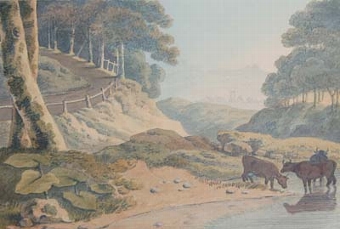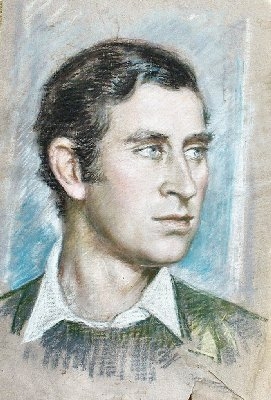the ring of brodgar, orkney
- View other items in:
- antiques interior design modern and vintage
- other interior design
artware ltd
Enquire about this antique
Artware Ltd has 565 antiques for sale.
click here to see them all
This watercolour is one of a small number of known works which Dayes was commissioned to prepare in 1789 from sketches made by John Thomas Stanley (1766-1850) and other hands during an expedition to northern Scotland and parts of Scandinavia. John Thomas Stanley, a friend of Sir Joseph Banks and later 1 st Lord Stanley of Alderley, embarked on this expedition in the summer of 1789. The party numbered twenty-six and sailed in the brig John leaving England on 26?th May. Stopping off at the Orkneys and the Faroe Islands en route, they reached Iceland on 4?th July, where Stanley was entertained by the Danish Governor, Count Levitzan. On his return, Stanley presented Banks with the collection of dried plants which he had gathered and gave his sketches to Edward Dayes and Nicholas Pocock (1740-1821) who both worked on the series of watercolours illustrating his travels.
Edward Dayes 1763-1804, water-colour painter and engraver in mezzotint, was born in 1763. He studied under William Pether, and began to exhibit at the Royal Academy in 1786, sending views of Waltham and Canterbury; in the three following years he exhibited miniatures as well as landscapes. He continued to exhibit there regularly till the year of his death, contributing in all sixty-four works. He also was an exhibitor at the Society of Artists. In 1798 he began to send classic and scriptural subjects, such as ?The Fall of the Angels? (1798), ?John preaching in the Wilderness? (1799), the ?Triumph of Beauty? (1800), and ?Elisha causing Iron to swim? (1801). Many of his drawings were crowded with
figures, which he drew with grace and spirit; among these were two views of the interior of St. Paul''s on the occasion of the thanksgiving for the king''s recovery in 1789, ?The Trial of Warren Hastings in Westminster Hall,? and ?Buckingham House, St. James''s Park? (1780), now in the South Kensington Museum. All these have been engraved. He drew much from nature in various parts of England, including the lake country and Wales, and his cleverly executed sketches in grey tints show much feeling for nature, and entitle him to a place among the precursors of the English school of water-colour. He was the master of Girtin, and his influence is perceptible in the early drawings of Turner. He was draughtsman to the Duke of York. He died by his own hand at the end of May 1804. In the South Kensington Museum he is represented by a fine view of Ely Cathedral (1792), and views of Windermere and Keswick Lake, all of which are remarkable (having regard to the time at which they were painted) for their luminous skies and aerial perspective.He engraved at least four plates in mezzotint, one after Morland, another after J. R. Smith, and two humorous scenes called ?Rustic Courtship? and ?Polite Courtship.? He wrote an ?Excursion through Derbyshire and Yorkshire,? ?Essays on Painting; Instructions for Drawing and Colouring Landscapes,? and ?Professional Sketches of Modern Artists.? After his death his works were collected and edited by E. W. Brayley, and published for the benefit of his widow in 1805.His wife painted miniatures and exhibited four works at the Royal Academy between 1797 and 1800. There are series of known watercolours of Orkney by Dayes some are in the Orkney museum and others are in private collections.
The Ring of Brodgar (or Brogar, or Ring o'' Brodgar) is a Neolithic henge and stone circle in Orkney, Scotland. Most henges don''t contain stone circles, Brodgar is a striking exception, ranking with Stonehenge and Avebury among the greatest of such sites. The ring of stones stands on a small isthmus between the Lochs of Stenness and Harray. These are the northernmost examples of circle henges in Britain. Unlike similar structures such as Avebury, there are no obvious stones inside the circle, but since the interior of the circle has never been excavated by archaeologists, the possibility remains that wooden items, for example, may be present. The site has resisted attempts at scientific dating and the monument''s age remains uncertain. However, it is generally thought to have been erected between 2500 BC and 2000 BC, and was, therefore, the last of the great Neolithic monuments built on the Ness. A project called The Ring of Brodgar Excavation 2008 was undertaken in the summer of the year in an attempt to settle the age issue and help answer other questions about a site that remains relatively poorly understood. The results of the excavation are still preliminary. The circle is 104 metres (340 ft) in diameter, and the third largest in the British Isles. The ring originally comprised 60 stones, of which only 27 remained standing at the end of the 20th century. The tallest stones stand at the south and west of the ring. The stones are set within a circular ditch up to 3 metres (9.8 ft) deep, 9 metres (30 ft) wide and 380 metres (1,200 ft) in circumference that was carved out of the solid sandstone bedrock by the ancient residents. Technically, this ditch does not constitute a true henge as there is no sign of an encircling bank of earth and rock. However, many archaeologists continue to refer to this structure as a henge; for example, Aubrey Burl classifies the ditch as a Class II henge; one that has two opposing entrances, in this case on the north-west and south-east[8]. Henge monuments are apparently unique to the British Isles and to the 3rd millenium BC.
Examination of the immediate environs reveals a concentration of ancient sites, making a significant ritual landscape. Within 2 square miles (5.2 km2) there are the two circle-henges, four chambered tombs, groups of standing stones, single stones, barrows, cairns, and mounds. The immediate area has also yielded a number of flint arrowheads and broken stone mace-heads that seem to date from the Bronze Age. Although its exact purpose is not known, the proximity of the Standing Stones of Stenness and its Maeshowe tomb make the Ring of Brodgar a site of major importance. The site is a scheduled ancient monument and has been recognized as part of the "Heart of Neolithic Orkney" World Heritage Site in 1999. The Heart of Neolithic Orkney? was inscribed as a World Heritage site in December 1999. In addition to the Ring of Brodgar, the site includes Maeshowe, Skara Brae, the Standing Stones of Stenness and other nearby sites. It is managed by Historic Scotland, whose ''Statement of Significance'' for the site begins:
The monuments at the heart of Neolithic Orkney and Skara Brae proclaim the triumphs of the human spirit in early ages and isolated places. They were approximately contemporary with the mastabas of the archaic period of Egypt (first and second dynasties), the brick temples of Sumeria, and the first cities of the Harappa culture in India, and a century or two earlier than the Golden Age of China. Unusually fine for their early date, and with a remarkably rich survival of evidence, these sites stand as a visible symbol of the achievements of early peoples away from the traditional centres of civilisation...The Ring of Brodgar is the finest known truly circular late Neolithic or early Bronze Age stone ring and a later expression of the spirit which gave rise to Maeshowe, Stenness and Skara Brae The first formal survey of the Ring of Brodgar and surrounding antiquities was performed in 1849 by Royal Navy Captain F.W.L. Thomas of HM cutter Woodlark. Captain Thomas was in the area drawing up Admiralty Charts in 1848-49, and he and his crew performed archaeological surveys as well resulting in the publication in 1852 of The Celtic Antiquities of Orkney.
Excavations by Orkney College at the nearby Ness of Brodgar site between the Ring and the Stones of Stenness have uncovered several buildings, both ritual and domestic and the works suggest there are likely to be more in the vicinity. Pottery, bones, stone tools and a polished stone mace head have also been discovered. Perhaps the most important find is the remains of a large stone wall which may have been 100 metres (330 ft) long and up to 6 metres (20 ft) wide. It appears to traverse the entire peninsula the site is on and may have been a symbolic barrier between the ritual landscape of the Ring and the mundane world around it. Invaders from Scandanavia reached Orkney by the 9th century, bringing a complex theology that they imposed on the preexisting Orcadian monuments; at least according to local legend. For example, the Ring of Brodgar and the Standing Stones of Stenness were allegedly known as the Temple of the Sun and Moon respectively[16]. Young people supposedly made their vows and prayed to Woden at these "temples" and at the so-called "Odin Stone" that lay between the stone circles until it was destroyed by a farmer in 1814. Others view these fanciful names with skepticism; Sigurd Towrie suggests that "they were simply erroneous terms applied by the antiquarians of the 18th or 19th centuries - romantic additions, in the same vein as the infamous "Druid''s Circle" and "Sacrificial Altar"." At the very least, several of the stones at Brodgar contain runic carvings that were left by Nordic peoples.
Burl notes that the diameter of the bank at Brodgar is almost exactly 175 megalithic yards, the same as the inner banks of the Avebury and Newgrange monuments in England and Ireland respectively. The so-called "megalithic yard", at 0.8297 metres (2.722 ft) per MY, is a controversial measure originally proposed by Alexander Thom. Thom''s thesis, based on a statistical analysis of Neolithic monuments in the United Kingdom, is that the builders of these sites employed a common unit of measurement, implying a transfer of incredibly precise information that may not have existed, even if it were possible: see Pseudoscientific metrology. Heggie casts doubt on this as well, stating that his careful analysis uncovered "little evidence for a highly accurate unit" and "little justification for the claim that a highly accurate unit was in use". Thom and his father made other controversial contentions, for example, that Brodgar and the burial mounds that surround it were designed specifically as backsights for astronomical observations of the Moon[. Graham Ritchie points out that the burial mounds have not been reliably dated, and he casts doubt on the astronomical prowess of the builders].Euan MacKie suggested that the nearby village of Skara Brae might be the home of a priviledged theocratic class of wise men who engaged in astronomical and magical ceremonies at sites like Brodgar and the Stenness. Graham and Anna Ritchie cast doubt on this interpretation noting that there is no archaeological evidence for the claim, although a Neolithic "low road" connects Skara Brae with the magnificient chambered tomb of Maeshowe, passing near Brodgar and Stenness. Low roads connect Neolithic ceremonial sites throughout Britain
Antiques.co.uk Ref: NXT3W3UT
- Materials:
- Pencil and Watercolour
- Width (cm):
- 12.70 x 17.78cm 5.00 x 7.00ins
Artware Ltd
Artware Fine Art specialises in fine antique, decorative and historical portraits and topographical pictures . We cover a period from the 17th and 18th centuries through to the 19th & 20th Centuries. We have over 150 portraits in stock, which can be viewed on our web site, each historical portrait has well researched biographical information both on the sitter and the artist.
Contact details
18 La gare
51 Surrey row
London
Greater London
SE1 0BZ
UNITED KINGDOM
T: 0207 921 97904
E: greg@artwarefineart.com
W: www.artwarefineart.com














